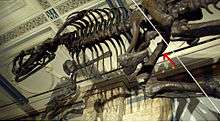Fourth trochanter

The fourth trochanter is a shared characteristic common to archosaurs. It is a knob-like feature on the posterior-medial side of the middle of the femur shaft that serves as a muscle attachment, mainly for the Musculus caudofemoralis longus, the main retractor tail muscle that pulls the thighbone to the rear.
The fourth trochanter first appeared in the Erythrosuchidae, large basal archosauriform predators of the early Triassic period.
This seemingly insignificant detail may have made the evolution of dinosaurs possible as it facilitates a bipedal gait. All early dinosaurs and many later ones were bipeds. It may also have been a factor in the archosaurs or their immediate ancestors surviving the catastrophic Permian-Triassic extinction event.
References
- Benton, M. J. (2000), Vertebrate Paleontology, 2nd Ed. p.136; (2004) 3rd edition, Blackwell Science Ltd